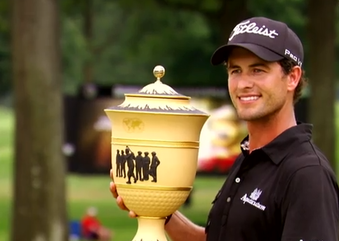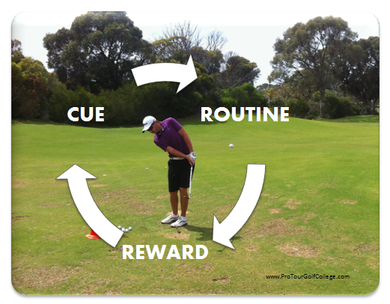 Adam Scott is the Product of Thousands of Hours of Special Practice Adam Scott is the Product of Thousands of Hours of Special Practice In the golf world we praise the victor but don’t think twice about the guy or gal who came second. We could care less about their rise from insignificance to significance. Because when we see a tour star put on the green jacket, or kiss the Open Championship trophy, or get showered by champagne following their victory we rarely if ever consider the thousands of hours of physical and mental investment it took to get them there. You see, we don’t respect the work load just the result. When we see the end result or package we see the attractive side of golf, the cheering galleries, the big cheques, the smiling faces, but what we don’t notice is what it took to get there. Top tour pros think clearly under pressure and this is one characteristic that separates them from those who melt like marsh mellows when the heat is turned up. I think it is fair to say that this one attribute of successful tour pros that is the difference that makes the difference. Pressure is a Privilege We teach our students at Pro Tour Golf College that pressure is a privilege. We want them to see that pressure is earned and that they should strive to put themselves in a situation that rewards them with it often as possible. We want them to embrace the challenge of the game and manage their fears, and learn to hit golf shots that set them up to win golf tournaments. We call golfers who can do this “tour tough” golfers and their behavior is often described by the media as possessing the gift of mental toughness, intestinal fortitude, grit or a never die attitude. They are praised for having this important attribute.  How You Can Become Tour Tough I think it’s important for you to understand that if you desire to become a top ranked amateur or indeed tournament golfer then you need to continually remind yourself of what I’m about to share with you. The tour tough golfer knows that you cannot let your emotions run riot on the golf course; you cannot lose your head when things don’t go your way. If you allow yourself to react this way you will invite disaster to your game. Can you imagine what it must be like for the amateur and professional golfers who sabotaged any success they might have enjoyed from golf by continually punishing themselves for every golf shot that they hit that didn’t come off the way they wanted? Believe me when I tell you that there are lots of golfers like that. For you to become successful in this game you must develop a very high level of tolerance for accepting the adversity that is the game of golf. So should you act more like a robot with no emotion chip you might be thinking? No, you act like someone who is focused and determined to achieve the goal of executing each golf shot to the best of your ability. And if this doesn’t occur and you can genuinely say that you attempted to do your best, then you have nothing to worry about. Just keep working on your golf skills and attitude until you achieve more of what you want. In case you didn’t know it, this has been the way success has been achieved forever.  The Tour Tough Golfer Framework You simply keep working on this process. And here’s where it’s interesting. The process is simply a loop that begins with a cue or trigger, then leads you through a routine or ritual, and ends with a result or reward. This three stage loop was discovered by researchers at MIT and describes the way we perform a habit to achieve an outcome. Do you get angry when you hit a golf shot that doesn’t meet your level of expectation? Why do you get angry? This is an important question. However the answer is often that you don’t know, that it just happens that way. Welcome to the world of habits. Want to know more about habits? http://charlesduhigg.com/how-habits-work/ Different golfers deal with adversity in many different ways, but you can be sure of one thing; if you can’t handle it then you need to change in a hurry because we know of golfers who develop miserable attitudes around this game because they continually practice the habit of getting upset when their shots fail to live up to the picture they created in their mind. The Cue or Trigger The cue or trigger sets your habit in motion, it’s like flicking on a light switch. And for most golfers it is so well learned that you won’t even know you do it. In other words, it will fire up and put you on the habit path unconsciously, and here for many lies the problem; if you get angry after hitting a bad shot then this was more than likely triggered by a cue.
We have noticed that anger loops are often associated with certain types of golf shots that the golfer often has difficulty playing when they perceive a change in pressure. They try to play a shot that in practice they manage quite well but when they need to play it when it matters to them and they don’t pull it off, they get can get as mad as hell. How does a cue like this develop? If you hit lots of pitch shots over a bunker for example, with a low level of commitment (going through the motions) and then you are faced with having to hit a shot that's similar only it’s on the golf course (possible at a crucial time) your perceived anxiety threshold changes, and this can trigger a routine that leads you to a poor shot that doesn’t come off the way you practiced it. And here’s where it gets a little strange. The reward in this case is the scolding or berating of yourself, expressing it either physically – say by slamming your golf club into the ground, a bag or something else, or a physical and verbal blast that could include swearing and throwing a club, or just simply verbal abuse inside your head. When you get mad in any of these ways you simply reinforce the habit loop so that it will happen again and again because you are emotionalizing the message of dissatisfaction to your brain, and its interpretation is that it must be important therefore you will want to remember it again...and again... Change the Reward to Change the Loop How do you stop it? The key is to change the reward part of the loop so that you change the loop itself to a better—more effective one. Your loops are usually made up of a thought (image) a feeling (emotion) and an action or behavior. So get your image of the shot you want to hit to be consistent with what you are capable of most of the time. Don’t try to pull-off shots that you can play just three times out of ten when it matters. Play shots that you can play seven times out of ten when it matters. Next match the feel of the stroke you are going to play to the image you are imagining. This is often described as your rehearsal and is an important part of the process of getting from the thought to the action. Lastly and the most important part; swing away and regardless of the outcome you produce, control your emotional response. The key is to acknowledge (after the shot has gone) that in that moment you did the best you could and that next time you will do it better. Don’t live in the past by getting bitter and twisted over shots that didn't come off the way you planned, move on to the next shot and practice accepting the shot you played, knowing that there always better shots ahead of you if you do one simple thing; practice rewarding habits that pay-off. Lawrie Montague and David Milne - Pro Tour Golf College Your Success On Tour is Our Business
Marc Cools
18/11/2013 08:49:05 am
Lots of stats on your site. Love it. Do you also have a stat on the improvement of your students? How many do make it to a major tour? What is the average score? How much improvement? 18/11/2013 12:30:07 pm
Thanks Marc for your comments and liking the stats in our articles. One of our players has played on the PGA Tour and achieved a world golf ranking of 34. Comments are closed.
|
Archives
June 2019
|
Proudly Supported By
Copyright © 2011 - 2018 Pro Tour Golf College
Website Managed By Golf Performance Media
All Rights Reserved
Website Managed By Golf Performance Media
All Rights Reserved


 RSS Feed
RSS Feed



